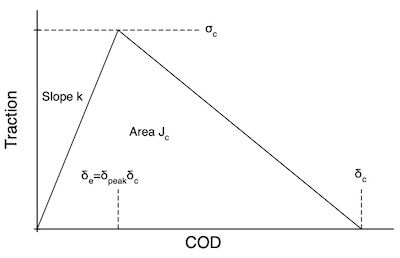Triangular Traction Law
The Traction Law
This traction law assumes the triangular shape for the cohesive law as a function of crack opening displacement (COD) during uniaxial, monotonic loading. There are separate and uncoupled cohesive laws for opening displacement (mode I) and sliding displacement (mode II).
The toughness of this cohesive law is the area under the curve or:
[math]\displaystyle{ J_c = {1\over 2} \sigma_c\delta_c }[/math]
When creating this traction law, you have to enter exactly two of these three properties for both mode I and mode II (i.e., two of JIc, σI, and δIc and two of JIIc, σII, and δIIc). Whichever property is not specified will be calculated from the two provided properties using one of the following relations:
[math]\displaystyle{ \delta_c = {2J_c\over \sigma_c}, \qquad \sigma_c = {2J_c\over \delta_c}, \qquad {\rm or} \qquad J_c = {1\over 2}\sigma_c\delta_c }[/math]
The initial linear-elastic rise can be defined by slope k or by the relative crack opening displacement at the peak stress, δpeak (which is entered relative to the critical opening displacement or the elastic COD to reach the peak is δe = δpeakδc). You can only enter one of these two properties (i.e., one of kIe and δI,peak and one of kIIe and δII,peak). The other will be calculated from:
[math]\displaystyle{ k = {\sigma_c\over \delta_{peak}\delta_c} \qquad {\rm or} \qquad \delta_{peak} = {\sigma_c\over k\delta_c} }[/math]
Alternatively, you can omit both k and δpeak. In the case, the default peak will be located at δpeak = 0.225926299. This location provides the closest match to the cubic traction law for area under the curve as a function of COD. The initial slope will be set to
[math]\displaystyle{ k = {\sigma_c\over 0.225926299 \delta_c} }[/math]
This implementation disallows zero of infinite initial stiffness (for stability reasons). In other words, the entered parameters must resolve to k>0 and δpeak>0.
Failure
The entered traction laws give mode I or mode II cohesive laws for pure mode I or pure mode II loading. Under pure mode load, the cohesive law will fail (and release the crack surfaces) when the COD reaches the critical COD (δc) for that mode. For mixed-mode loading, however, such uncoupled failure is not realistic. To make uncoupled mode I and mode II laws a viable approach to modeling mixed-mode failure, one has to impose a failure criterion.[1] This traction law assumes failure occurs when:
[math]\displaystyle{ \left({G_I\over J_{Ic}}\right)^{n} + \left({G_{II}\over J_{IIc}}\right)^{n} = 1 }[/math]
where GI and GII are areas under mode I and mode II traction laws up to current maximum COD and n is mixed-mode failure criterion parameter. This failure criterion will mean that failure may occur when normal or shear tractions are nonzero. In other words, each traction law will have COD less then their critical COD, which means their traction will be greater than zero. Because failure releases the crack surfaces, mixed-mode failure by this criterion may result in a sudden drop of finite normal and shear traction to zero traction. Such drops might cause numerical issues.
Although use of uncoupled mode I and mode II laws with a failure criterion is common in cohesive zone models[1], other models have coupled the mode I and II traction laws such that they always approach zero at time of failure (e.g., work of Högberg (2006),[2] Camacho and Ortiz (1996),[3] and Comanho (1996)[4]). The Högberg model is implemented in the Coupled Traction Law. These approaches are based on defining an effective displacement. A recent re-analysis of cohesive zones, however, has shown these models are invalid unless the normal and tangential laws are scaled copies of each other.[5] A better approach based on this re-analysos[5] that couples mode I and mode II and remains valid for arbitrary normal and tangential laws is now the recommended model for mixed mode failure and is implemented in the Mixed Mode Traction Law.
Traction Law Properties
The following properties are used to create a triangular traction law:
| Property | Description | Units | Default |
|---|---|---|---|
| kIe | Initial elastic slope when opened, k in mode I | pressure/length units | none |
| delpkI | COD for peak stress, δpeak, relative to critical COD in mode I (0 to 1) | dimensionless | none |
| kIIe | Initial elastic slope, k in mode II | pressurelength units | none |
| delpkII | COD for peak stress, δpeak, relative to critical COD in mode II (0 to 1) | dimensionless | none |
| (other) | Properties common to all traction laws | varies | varies |
The resulting laws are required to have kIe, delpkI, kIIe, and delpkII as entered (or as calculated) must all be greater than zero. In other words, for stability reasons, the initial stiffness cannot be infinite.
Traction History Variables
This material tracks two history variables:
- Maximum normal opening displacement
- Maximum shear opening displacement (absolute value)
These history variables can be archived for later plotting. The cmdisp archiving option can archive total mode I and mode II cumulative dissipated energies.
References
- ↑ 1.0 1.1 Q.D.Yang and M.D.Thouless,"Mixed-mode fracture analysis of plastically-deforming adhesive joints," International Journal of Fracture, 110, 175–187 (2001).
- ↑ J. L. Högberg, "Mixed mode cohesive law," International Journal of Fracture, 141, 549–559(2006)
- ↑ G. T. Camacho and M. Ortiz, "Computational modelling of impact damage in brittle materials," Int. J. Solids Struct., 33, 2899–2938 (1996)
- ↑ P.P.Camanho and C.G.Dàvila, "Mixed-mode decohesion finite elements for the simulation of delamination in composite materials, Tech. report, NASA/TM-2002-211737 (2002)
- ↑ 5.0 5.1 J. A. Nairn and Y. E. Aimene "A re-evaluation of mixed-mode cohesive zone modeling based on strength concepts instead of traction laws" in preparation (2020).
